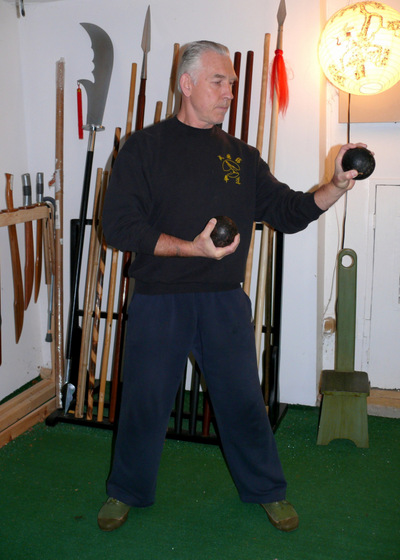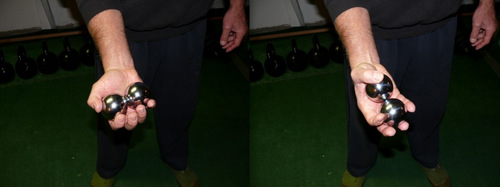Introduction
It is well known that anyone involved in contact sports or combat training needs to strengthen four key areas—the neck, the lower back, the hips and legs, and the hands and wrists. This approach was emphasized by Maurice Ainsworth, my first strength and martial arts teacher. In addition, the effectiveness of this method of body-building was reinforced by fourteen years of training with traditional “un-famous” teachers in Japan and China.
I say “un-famous” because, in true Dinosaur style, they could only be found hidden away in back alleys or in a countryside village. Often, these unsung instructors only took in a handful of students, and the students trained, ate and slept in their teacher’s living room. The teachers taught the old way, and every-day articles were used for strength training. Such articles included earthenware jars and bamboo poles. In this article, I will present the type of exercises they taught to develop extraordinary grip and wrist strength.
Firstly, when we talk about building hand and wrist strength in traditional martial arts, top consideration is given to the chain of connections across the elbows, shoulders, spine, hips, legs, and feet. Any hand technique can be enhanced by a firm connection of the feet to the ground. This type of contact generates very large reactionary forces which are transmitted across the hips, the spine, the shoulders, and the arm. From the arm, these forces culminate in the active hand and deliver quite a powerful impact. It is easy to see that the same mechanism is involved in any heavy pressing or pulling movement. So, while we are working the wrists, we should also engage the whole body.
Now that we have the pertinent theory behind us, let's take a look at six result-producing exercises from traditional martial arts which can dramatically strengthen the wrist and fingers. If you practice these muscle-builders regularly and as described below, it won't be long before you have a grip of steel. I can assure you of this.
Exercise 1: Jar Lift and Hold
Traditionally, earthenware was used for this exercise because it was readily available. There are still pot makers in Okinawa who will custom mold earthenware to a practitioner’s hand. However, glass (don’t drop it), plastic or tin cans can be used as a viable alternative. Just fill your chosen container with enough sand or shot to give sufficient resistance. Then, add more sand as your strength progresses.
Two effective variations for strengthening the grip with the Jar Lift and Hold are explained in Steps A and B below:
- Stand in a horse stance with a weighted jar resting in front of you. Then, pick up the jar by the tips of your fingers and hold it straight out in front of you (or to your side for variation). Repeat this process with your other hand and keep the alternating sequence going until both of your hands are thoroughly taxed. (See Cover Photo above and Photo 1 below.)
- Perform movement as described in Step A, but move your arm slowly from front to side and back again. Again, alternate arms for the desired number of sets and repetitions.

Exercise 2: Gripping with an Iron Circle
This exercise was originally done by forming a circle with five bamboo stakes stuck in the ground to which a looped cord was attached. Each finger and thumb fit in a loop, and they were drawn together and held for time, or a continuous sequence of repetitions was performed. As a trainee's strength increased, a thicker bamboo was used.
Around the 1970’s the Iron Circle “High Tech” apparatus (shown in Photo 2 below) was developed, and this device was all the rage in Hong Kong and Japan. What I like about this grip builder is that you can use your thumb and work the device with either one, two, three, or all four of your remaining fingers.

Exercise 3: Gripping of Iron Spheres
Iron spheres typically weigh from 5 to 20 pounds each. While gripping the whole sphere various pushing or drawing-in movements can be made. Two particularly good movements that should be done in sequence while working with iron spheres are the “brush on” and the “brush off”. This dual combination was made famous by the original "Karate Kid" movie.
To perform the “brush on” / “brush off” grip builder, hold a pair of spheres with your palms down , and bring your hands up to head height (“brush on”, photo 3). Then, lower the spheres to waist height as you flex your palms up (“brush off”, Photo 4). Repeat for a desired number of repetitions.


An effective variation of the “brush-on” / “brush-off” exercise described above is similar to a reverse “Zottman Curl”. To perform this variation, curl an iron sphere palm up and close to your chest. Then, rotate your wrist to the palm-down position and lower the sphere to your side in a circular motion. You can do this exercise one arm at a time while holding a single sphere, or while holding two spheres and alternating hands (Photo 5).

Exercise 4: Fingertip Pushups
In many traditional martial arts, the palm heel, the side of the hand, and the fingers are often utilized more than the clenched fist. Fingers are trained to be like iron spikes. Chojun Miyagi, the founder of Goju Ryu karate, was reputed to be able to thrust his hand into a side of beef.
Regularly performing the fingertip pushup (Photo 6) is an excellent way to develop this type of strength. It is important to perform the pushups on the tips of the fingers and not on the pads. Gradual progress can be made by omitting one finger at a time. Sifu Luo Guo Hua, my teacher in China, could do thumbs-only pushups. Another way to make this exercise harder and more progressive is to raise your feet on a bench, or even go into a handstand against a wall.

Exercise 5: Sandbag Swing and Catch
This exercise (Photo 7) is done with a weighted sandbag, usually from 5 to 30 pounds. The starting position is the same as the dumbbell or kettlebell swing. Release the bag at head height and shoot other hand out to grab the bag, digging in with your fingertips. This movement also makes a good finisher to a regular workout.

Exercise 6: Gripping of Tai Chi Balls
Regular gripping of tai chi balls will do much to increase the dexterity and flexibility of your fingers. This exercise may be practiced either at the end of your normal workout or on your “off” days. The tai chi balls I use weigh about one pound each. I recommend holding the balls to the side at arm's length, palms up of course (Photo 8). The idea is to manipulate the tai chi balls so that they are continuously circling each other.
Performed at the end of a heavy workout, this exercise gives a real burn; on “off” days it gives a nice warm glow. You can use the type of tai chi balls sold in most Chinese goods stores if you prefer, but I find these to be too light. Many most trainees, a better bet would be to use large ball bearings. The ones I use weigh about one pound each.

Epilogue
That’s it. I hope there are at least one or two exercises presented here that you would like to add to your training collection. Do not forget to engage the whole-body floor-to-hand connection while doing these. This is very important.
Here are a few notes to consider before you engage in your new grip-building program:
- Traditional martial artists would also use various liniments to toughen their bones and tendons, much like the old–time boxers would soak their hands in brine. This subject is beyond the scope of this article, but you may want to do a bit of research about this subject.
- To strengthen the grip, it is common in traditional martial arts to do rapid opening and closing of the fists (50-100 times each) between heavy grip-training sessions.
- Grip-building exercises common to strength training in the West, such as wrist rolling and pinch gripping, are also often used in traditional martial arts to strengthen the grip.

Add Comment